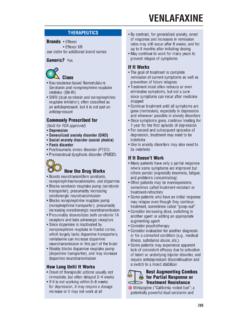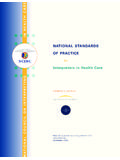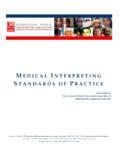Transcription of “Continuing Education: Cultural and Linguistic Competency”
1 Continuing Education: Cultural and Linguistic Competency . CALIFORNIA ASSEMBLY BILL 1195 & ACCME'S EA With the passage of CA Assembly Bill 1195, continuing medical education courses with patient care components are required to include curriculum in the subjects of Cultural and Linguistic competency. It is the intent of the bill, which went into effect on July 1, 2006, to encourage physicians, CME providers in the state of California, and the Accreditation Council for Continuing Medical Education to meet the Cultural and Linguistic concerns of a diverse patient population through appropriate professional development. The planners, speakers, and authors of this CME activity have been encouraged to address issues relevant to their topic area. In addition, a variety of resources addressing Cultural and Linguistic competency are included in this handout.
2 DEFINITIONS. Cultural competency is defined as a set of integrated attitudes, knowledge, and skills that enables a health care professional or organization to care effectively for patients from diverse cultures, groups, and communities. At a minimum, Cultural competency is recommended to include the following: Applying Linguistic skills to communicate effectively with the target population. Utilizing Cultural information to establish therapeutic relationships. Eliciting and incorporating pertinent Cultural data in diagnosis and treatment. Understanding and applying Cultural and ethnic data to the process of clinical care. Linguistic competency is defined as the ability of a physician or surgeon to provide patients who do not speak English or who have limited ability to speak English, direct communication in the patient's primary language.
3 RESOURCES*. Following is a list of useful Cultural and Linguistic competency resources. Major Resources 1. Diversity Rx Department: links to national Linguistic and Cultural programs 2. University of California, San Francisco, School of Medicine, CME Cultural and Linguistic Competency Resources. 3. Department of Health and Human Services Health Resources and Services Administration. Cultural Competence Resources for Health Care Providers . 4. Department of Health and Human Services The Office of Minority Health. 5. Georgetown University National Center for Cultural Competence 6. The Cross Cultural Health Care Program. NEI Handout--Continuing Education: Cultural and Linguistic Competency. continued References and Articles on Cultural and Linguistic Competency 1. AB 801 Assembly Bill Chaptered. Official California Legislative Information website.
4 (cited 7 Nov. 2005). 2. National Health Law Program, Library: Health Disparities. page 1 of 3. 3. National Health Law Program, Library: Language Access. Additional Resources 1. Georgetown University National Center for Cultural Competence: Self-Assessment Checklist for Personnel Providing Primary Health Care Services . 2. National Initiative for Children's Healthcare Quality (NICHQ). Expanding Perspectives, Improving Cultural Competency in Children's Health Care . 3. Department of Health and Human Services The Office of Minority Health: National Standards for Culturally and Linguistically Appropriate Services in Health Care . (executive summary). 4. (final report). 5. America's Health Insurance Plans (AHIP), Center for Policy and Research. Innovations in Medicaid Managed Care. March, 2005. Chapter 6, Addressing Cultural Diversity.
5 Eport_ 6. "I Speak" Language Identification Flashcard: Department of Commerce, Economics and Statistics Administration, Census Bureau. 7. On-line dictionary providing translations into 25 different languages (free). 8. National Council on Interpreting in Health Care 9. University of California, SF Fresno Center for Medical Education & Research: Hablamos Juntos: Language Policy and Practice in Health Care. program for improving patient-provider communication for Latinos 10. Georgetown University National Center for Cultural Competence: Curricula Enhancement Module Series. 11. National Patient Safety Foundation Partnership for Clear Health Communication. Ask Me 3 . 12. Cross Cultural Health Care Program store: bilingual medical glossaries, books, videos, articles/downloads NEI Handout--Continuing Education: Cultural and Linguistic Competency.
6 Continued 13. The Bilingual Medical Interview I (1987) and The Bilingual Medical Interview II: The Geriatric Interview, Section of General Internal Medicine, Boston City Hospital, in collaboration with the Department of Interpreter Services and the Boston Area Health Education Center (Available from the BAHEC, Boston Public Health Commission, 1 Boston Medical Center Place, NEB-2, Boston, MA 02118;. Phone (617) 534-5258). 14. The Kaiser Permanente/California Endowment Clinical Cultural Competency Video Series. "Trigger". videos to be used as teaching tools for training healthcare professionals in Cultural competence. Videos comprise three sets, each with accompanying facilitator's guide and contextual materials. The scenarios are from eight to fourteen minutes long. Contact Gus Gaona (323-259-4776) at Kaiser Permanente MultiMedia Communication, 825 Colorado Boulevard, Suite 301, Los Angeles, CA.
7 90041. 15. Quality Care for Diverse Populations . Video/CD-ROM/Facilitator's Guide. Five video vignettes depicting simulated physician-patient visits in an office setting, to explore ethnic and sociocultural issues. Produced by the American Academy of Family Physicians (AAFP), with partial funding by the Bureau of Primary Health Care, Health Resources and Services Administration, 2002. 16. Worlds Apart . A Four-Part Series on Cross- Cultural Healthcare. By Maren Grainger- Monsen, MD, and Julia Haslett, Stanford University, Center for Biomedical Ethics. page 2 of 3. 17. The Culture of Emotions: A Cultural Competence and Diversity Training Program . Harriet Koskoff, Producer/Co-Coordinator. Fax 415-621-8969. 18. Department of Health and Human Services The Office of Minority Health: A Physician's Practical Guide to Culturally Competent Care Web site.
8 19. The Provider's Guide to Quality and Culture. Management Sciences for Health, Inc. Electronic Resource Center. ggroup=&mgroup=. 20. Measuring Health Disparities , free interactive CD-ROM. John Lynch, PhD, and Sam Harper, PhD, McGill University. Produced by the Michigan Public Health Training Center (MPHTC). *Links last verified on 7/14/2016. page 3 of 3.





